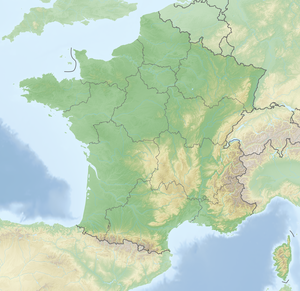Fontaine de Fontestorbes
| Fontaine de Fontestorbes | |||
|---|---|---|---|
 Fontaine de Fontestorbes |
|||
| location | |||
| Country or region | Ariège department , Occitania region ( France ) | ||
| Coordinates | 42 ° 53 ′ 33 " N , 1 ° 55 ′ 36" E | ||
|
|||
| geology | |||
| Mountains | Pyrenees | ||
| Source type | Karst spring | ||
| Exit type | Spring grotto | ||
| rock | limestone | ||
| Hydrology | |||
| River system | Garonne | ||
| Receiving waters | Hers-Vif → Ariège → Garonne → Atlantic Ocean | ||
| Bulk | 2090 l / s | ||
Coordinates: 42 ° 53 ′ 33 " N , 1 ° 55 ′ 36" E

The Fontaine de Fontestorbes , also called Source de Fontestorbes or Fontaine intermittente de Fontestorbes , is an intermittent karst spring near Bélesta in the Pyrenees in the Occitania region in the Ariège department in France .
description
The Fontaine de Fontestorbes is located next to the road, about one kilometer southwest of the town of Belesta , on the right side of the slope in the wooded valley of the Hers-Vif . The karst spring pours an average of 2090 liters per second. The spring water springs from a cave opening in a rock. It comes from an approximately 85 km² underground lake, which is largely fed by water that seeps into the limestone of the Plateau de Sault . The river that rises there can be up to five meters wide. After about 50 m from the right it joins the Hers-Vif.
Five other sources of this type are currently known in France, including the Source intermittente de Fontaine-Ronde .
Suspending the pour
The flow of the karst spring is mostly even. From July to October, however, strong fluctuations in the discharge can be observed, to which the spring owes its widespread fame as a tourist attraction. If the pouring stops, the outflow from the spring is enormously strong for about 20 minutes and is then suddenly interrupted for about 40 minutes. This cycle repeats itself continuously.
Science background
The mechanisms that lead to the intermittent of the Fontaine de Fontestorbes have not yet been fully explored. The following presentation is based on studies from the late 1970s by the CNRS, mainly by Alain Mangin.
Pour interruptions only occur in times of low water level, i.e. when the current flow rate is below 1040 liters per second. According to current theory, intermittent is based on the interaction of three components:
- A natural, underground water reservoir that is located upstream in a cavity in the limestone massif, where the water from the catchment area collects.
- A tunnel that begins at the lower end of this underground lake and directs the water flowing off there to the outlet of the spring.
- A second, higher tunnel to the underground lake, which is filled with air.
For the intermittent source to function, it is important that the end points of both tunnels are next to each other and at approximately the same level. Thus, when the water level is sufficient, the air shaft remains closed, as if it were not there. Therefore, the flow normally exits in the same amount as the inflow. The source flows continuously . When the inflow into the lake subsides, it finally falls below the value of 1040 l / s and the water level in the lake drops.
As a result, the end of the air tunnel, which was previously under water and therefore closed, is now partially above the water level . This allows air to be sucked into the cavity via this tunnel, which leads to an abrupt and severe pressure drop in the drainage tunnel. The drainage comes to an almost complete standstill and the source outlet dries up. Since the outflow is now almost completely blocked and well below the inflow rate, the water level of the lake is refilled.
However, in order to restart the flow in the drainage tunnel, the water level must rise above the level that caused the interruption. When this is done, the flow at the outlet of the source will be up to 1800 l / s. The cycle is thus repeated as long as the inflow from the catchment area is insufficient to guarantee a permanent flow. This is usually the case throughout the summer, only interrupted for a few days after violent thunderstorms. The cycle time is extended towards the end of the season when the very low inflow takes longer to fill the lake back to the required water level.
While this simplified representation suggests a theoretically perfect regularity of the mechanism, the actual relationships are somewhat more differentiated. During the season, minimum flow rates between 200 l / s at the beginning and 20 l / s in late summer were measured. The maximum discharge also varies between 1800 and 1680 l / s.
In some rare cases, the reservoir can no longer fill due to extreme dryness and water and air flow constantly to the outside via the drainage line. This happens when the inflow falls below 600 l / s. This was the case in some longer periods of low water, for example in November 1973, October 2001 and January 2007. This observed value corresponds almost exactly to the calculations of A. Mangin, who had stated 680 l / s.
See also
Web links
Remarks
- ↑ In 2013, the spring did not fail until the end of July. The reason for this is probably the rainy spring.
